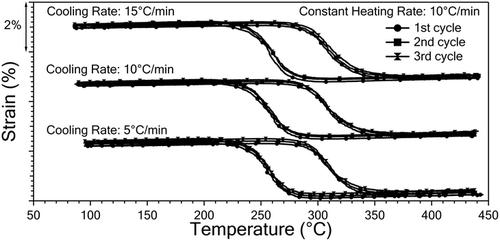Journal of Materials Research ( IF 2.7 ) Pub Date : 2020-06-17 , DOI: 10.1557/jmr.2020.139 Ogulcan Akgul , Halil O. Tugrul , Benat Kockar

|
In this study, the effect of the cooling rate on the thermal and thermomechanical behavior of NiTiHf high-temperature shape memory alloy was studied by differential scanning calorimetry and via running isobaric thermal cycling experiments. The cooling rates were set to 5, 10, and 15 °C/min for each cycle in both experiments, while the heating rate was kept as 10 °C/min. It was found that the transformation temperatures and thermal hysteresis values do not depend on the change in the cooling rate. On the other hand, the austenite to martensite transformation enthalpy as measured from DSC analyses increases with the increase in the cooling rate due to the higher measurement sensitivity at higher scanning rates. Recoverable strain values which were determined from isobaric thermal cycling experiments do not differ since the transforming volume does not change with the change of the cooling rate. All these findings are explained based on the fundamental thermodynamical approach.
中文翻译:

冷却速率对NiTiHf高温形状记忆合金热力学性能的影响
在这项研究中,通过差示扫描量热法和热力学研究了冷却速率对NiTiHf高温形状记忆合金的热和热机械行为的影响。进行等压热循环实验。在两个实验中,每个循环的冷却速率均设置为5、10和15°C / min,而加热速率保持为10°C / min。已经发现,转变温度和热滞后值不取决于冷却速率的变化。另一方面,由DSC分析测得的奥氏体到马氏体转变焓随着冷却速率的增加而增加,这归因于在较高扫描速率下较高的测量灵敏度。通过等压热循环实验确定的可恢复应变值没有差异,因为转变量不会随冷却速率的变化而变化。所有这些发现都基于基本的热力学方法进行了解释。











































 京公网安备 11010802027423号
京公网安备 11010802027423号